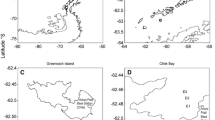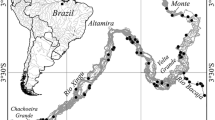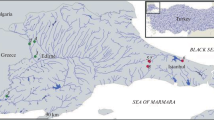Abstract
We tested the hypothesis that the highly flexible feeding repertoire of juvenile Chaetodipterus faber reflects their trophic adaptability by quantifying the feeding behaviour of juveniles in situ, for the first time, in a northeastern Brazilian estuary. The fishes presented a preference for alga-rich habitats, irrespective of the substrate type chosen during feeding bouts. The analysis of stomach contents revealed omnivorous feeding habits, indicating that the ingestion of plant material occurs incidentally during foraging for benthic prey hidden under the alga. Particulate feeding in the water column was often as important as bottom feeding on alga-rich substrates. The results of this study are consistent with those of other ephippid species in different coastal environments, which typically exploit an ample diversity of food items from different substrates. Therefore, the flexibility observed in the feeding behavior of the most ephippid species may be a fundamental determinant of the ecological success of this group.



Similar content being viewed by others
References
Abramoff, M. D., P. J. Magelhaes & S. J. Ram, 2004. Image processing with ImageJ. Biophotonics International 11: 36–42.
Barros, B., Y. Sakai, H. Hashimoto & K. Gushima, 2008. Feeding behaviors of leaf-like juveniles of the round batfish Platax orbicularis (Ephippidae) on reefs of Kuchierabu-jima Island, southern Japan. Journal of Ethology 26: 287–293.
Barros, B., Y. Sakai, H. Hashimoto & K. Gushima, 2011. Effects of prey density on nocturnal zooplankton predation throughout the ontogeny of juvenile Platax orbicularis (Teleostei: Ephippidae). Environmental Biology of Fishes 91: 177–183.
Barros, B., Y. Sakai, H. Hashimoto, K. Gushima & M. Vallinoto, 2012. ‘Better off alone than in bad company’: agonistic colour display in mimetic juveniles of two ephippid species. Journal of Fish Biology 81: 1032–1042.
Bellwood, D. R., T. P. Hughes & A. S. Hoey, 2006. Sleeping functional group drives coral-reef recovery. Current Biology 16: 2434–2439.
Bittencourt, M. L., 1990. Preliminary investigations about trophic relations of Atlantic-spadefish Chaetodipterus faber (Broussonet, 1782), (Pisces, Ephippidae) in the Guaraquecaba Bay, estuarine complex of Paranagua (Parana State, Brazil). Brazilian Archives of Biology and Technology 33: 195–203.
Breder, C. M. Jr., 1946. An analysis of the deceptive resemblances of fishes to plant parts, with critical remarks on protective coloration, mimicry and adaptation. Bulletin of the Bingham Oceanographic Collection 10: 1–49.
Couto, L. M. M. R. & A. L. Vasconcelos Filho, 1980. Estudo ecológico da região de Itamaracá, Pernambuco – Brasil. VIII sobre a biologia de Chaetodipterus faber (Broussonet, 1782) Pisces – Eppiphidae, no Canal de Santa Cruz. Trabalhos de Oceanografia da Universidade Federal de Pernambuco 15: 311–322.
Dantas, D. V., M. Barletta, J. A. A. Ramos, A. R. A. Lima & M. F. da Costa, 2013. Seasonal diet shifts and overlap between two sympatric catfishes in an estuarine nursery. Estuaries and Coasts 36: 237–256.
Ditty, J. G., R. F. Shaw & J. S. Cope, 1994. A re-description of atlantic spadefish larvae, Chaetodipterus faber (family: Ephippidae), and their distribution, abundance and seasonal occurrence in the northern Gulf of Mexico. Fishery Bulletin 92: 262–274.
Gerking, S. D., 1994. Feeding Ecology of Fish. Academic, London: 416 pp.
Hartley, P. H. T., 1948. Food and feeding relationships in a community of fresh water fishes. Journal of Animal Ecology 17: 1–14.
Hayse, J. W., 1990. Feeding habits, age, growth and reproduction of atlantic spadefish Chaetodipterus faber (Pisces: Ephippidae) in South Carolina. Fishery Bulletin 88: 67–83.
Heemstra, P. C., 2001. Ephippidae – spadefishes (batfishes). In Carpenter, K. E. & V. Niem (eds), FAO Species Identification Guide for Fishery Purposes. The living marine resources of the western central Pacific, Vol. 6. FAO, Rome: 3611–3622.
Humann, P. & N. DeLoach, 2002. Reef Fish Identification: Florida, Caribbean, Bahamas, 3rd ed. New World Publications, Florida: 481 pp.
Krumme, U., H. Keuthen, M. Barletta, W. Villwock & U. Saint-Paul, 2005. Contribution to the feeding ecology of the predatory wingfin anchovy Pterengraulis atherinoides (L.) in north Brazilian mangrove creeks. Journal of Applied Ichthyology 21: 469–477.
Kuiter, R. H. & H. Debelius, 2001. Surgeonfishes, Rabbitfishes and Their Relatives: A Comprehensive Guide to Acanthuroidei. TMC Publishing, Chorleywood: 208 pp.
Lehner, P. N., 1998. Handbook of Ethological Methods, 2nd ed. Cambridge University Press, Cambridge: 672 pp.
Lima-Junior, S. E. & R. Goiten, 2001. A new method for the analysis of fish stomach contents. Acta Scientiarum 23: 421–424.
Nanake, Y., Y. Suda & M. Sano, 2011. Food habits of fishes on an exposed sandy beach at Fukiagehama, South-West Kyushu Island, Japan. Helgoland Marine Research 65: 123–131.
Nanjo, K., H. Kohno & M. Sano, 2008. Food habits of fishes in the mangrove estuary of Urauchi River, Iriomote Island, southern Japan. Fisheries Science 74: 1024–1033.
Nelson, J. S., 2006. Fishes of the World, 4th ed. Wiley, Hoboken, NJ. 624 pp.
R Core Team, 2013. R: A Language and Environment for Statistical Computing. R Foundation for Statistical Computing, Vienna, Austria. http://www.R-project.org/.
Ramos, R. J., M. P. Travassos & G. R. Leite, 2010. Characterization of macrofauna associated with articulated calcareous algae (Corallinaceae, Rhodophyta) occurring in a hydrodynamic gradient on the Espírito Santo state coast, Brazil. Brazilian Journal of Oceanography 58: 275–285.
Randall, J. E. & H. A. Randall, 1960. Examples of mimicry and protective resemblance in tropical marine fishes. Bulletin of Marine Science 10: 444–480.
Stephens, D. W. & J. R. Krebs, 1986. Foraging Theory. Princeton University Press, Princeton, NJ: 262 pp.
Trushenski, J., A. Rombenso, M. A. Schwarz, J. Bowzer, B. Gause, B. Delbos & L. A. Sampaio, 2012. Feeding rate and frequency affect growth of juvenile Atlantic spadefish. North American Journal of Aquaculture 74: 107–112.
Van Tiendere, P. H., 1991. Evolution of generalists and specialists in spatially heterogeneous environments. Evolution 45: 1317–1331.
Williams, L. G. & H. L. Blomquist, 1947. A collection of marine algae from Brazil. Bulletin of the Torrey Botanical Club 74: 383–397.
Acknowledgments
We would like to thank U. Scofield, A. Schmidt, J. Jesus and E. Lemos (CEPENE), J. Neto (ICMBio), E. M. Chaves, R. Moura and R. Francini-Filho (Conservation International) for logistic support during the course of this study; E. Varela and D. Sodré (IECOS-UFPA) and J. Ha (Washington University), and the two anonymous referees for their critiques and much appreciated suggestions; P. C. Pretz (ESPM) for his technical support; and S. Kashima and K. Nakamura (Hiroshima University) for technical support in the field. We are grateful to S. F. Ferrari (UFS) for proofreading the manuscript. Thanks are also due to the Brazilian Council for Research and Development (CNPq, Grant #141225/2008-4) and the Brazilian Federal Agency for the Support and Evaluation of Graduate Education (CAPES, Process #6718-10-8) for financial support. Both observation and sampling activities were authorized by Brazilian authorities, under SISBIO license # 18963-2.
Author information
Authors and Affiliations
Corresponding author
Additional information
Handling editor: M. Power
Rights and permissions
About this article
Cite this article
Barros, B., Sakai, Y., Abrunhosa, F.A. et al. Trophic adaptability of late juvenile Atlantic spadefish Chaetodipterus faber (Teleostei: Ephippidae) related to habitat preferences in an estuary in northeastern Brazil. Hydrobiologia 717, 161–167 (2013). https://doi.org/10.1007/s10750-013-1574-x
Received:
Revised:
Accepted:
Published:
Issue Date:
DOI: https://doi.org/10.1007/s10750-013-1574-x




